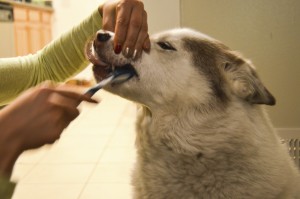Awareness Is Everything: The Importance Of Pet Dental Health
 One of the most common diseases seen by most veterinarians is pet dental disease, and it’s no surprise. Up to 85% of dogs and cats show signs of dental disease by age 3 and lack of dental care can cause the disease to worsen over time.
One of the most common diseases seen by most veterinarians is pet dental disease, and it’s no surprise. Up to 85% of dogs and cats show signs of dental disease by age 3 and lack of dental care can cause the disease to worsen over time.
February 1 marks the beginning of pet dental health month for regular wellness veterinarians. What better time to brush up on the ins and outs of pet dental health and the ways you can work with your veterinarian to help maintain your pet’s dental and overall health?
The Link Between Oral Health And Longevity
Dental disease, also known as periodontal or gum disease, is an infection of the soft tissue and supporting structures of the teeth caused by a buildup of bacteria along the gum line.
Besides causing significant pain and potential tooth loss for your pet, untreated dental disease can trigger a wide variety of systemic problems. As periodontal disease progresses, bacteria make their way to the bloodstream and travel throughout the body, potentially causing damage to vital organs such as kidney, liver, and heart.
By keeping your pet’s teeth in good shape, you are protecting him or her from serious problems down the road. A healthy mouth can truly add years to your pet’s life.
Signs Of Dental Disease In Pets
That doggy breath you’ve come to know and love is just one of the many indicators that your pet may be suffering from dental disease. Make an appointment with your veterinarian right away if you notice any of the following symptoms in your pet. These are indicators of periodontal disease that has progressed into dental issues.
- Foul breath
- Excessive drooling, especially in cats
- Broken, worn, or discolored teeth
- Loose teeth
- Swollen or inflamed gums
- Bleeding from mouth
- Pawing at the mouth
- Loss of appetite or difficulty eating
What You Can Do
A dedicated home care routine is essential to your pet’s dental health. By investing your time and energy in keeping your pet’s teeth clean today, you will be helping to prevent the decay that could lead to a decline in your pet’s health tomorrow.
Brush, brush, brush – Yes, you have to brush your pet’s pearly whites regularly, using a pet-friendly toothpaste (never use human toothpaste, as it contains ingredients that can be toxic to pets).
Visit your vet – Keeping your pet’s regularly scheduled wellness exams are vital to his or her oral health. By examining your pet’s mouth at each visit, your vet will be able to catch problems early and make recommendations as to home care and follow up professional care. Most pets should receive regular professional dental cleanings and examinations for optimal oral health.
Chew on this – While chewing should never be used in place of brushing or professional dental care, chewing on certain dental treats and chew toys can help scrape some of the tartar from your pet’s teeth. Your veterinarian may also recommend a prescription food formulated specifically for plaque reduction.
Your Pet’s Dental Health Begins With You
There’s no reason why your pet shouldn’t benefit from the ever-growing field of veterinary dentistry now that we know its importance to your pet’s overall health. By keeping up with your pet’s regular wellness visits and committing to a good home care routine, you can keep your pet happy, healthy, and comfortable for years to come.


